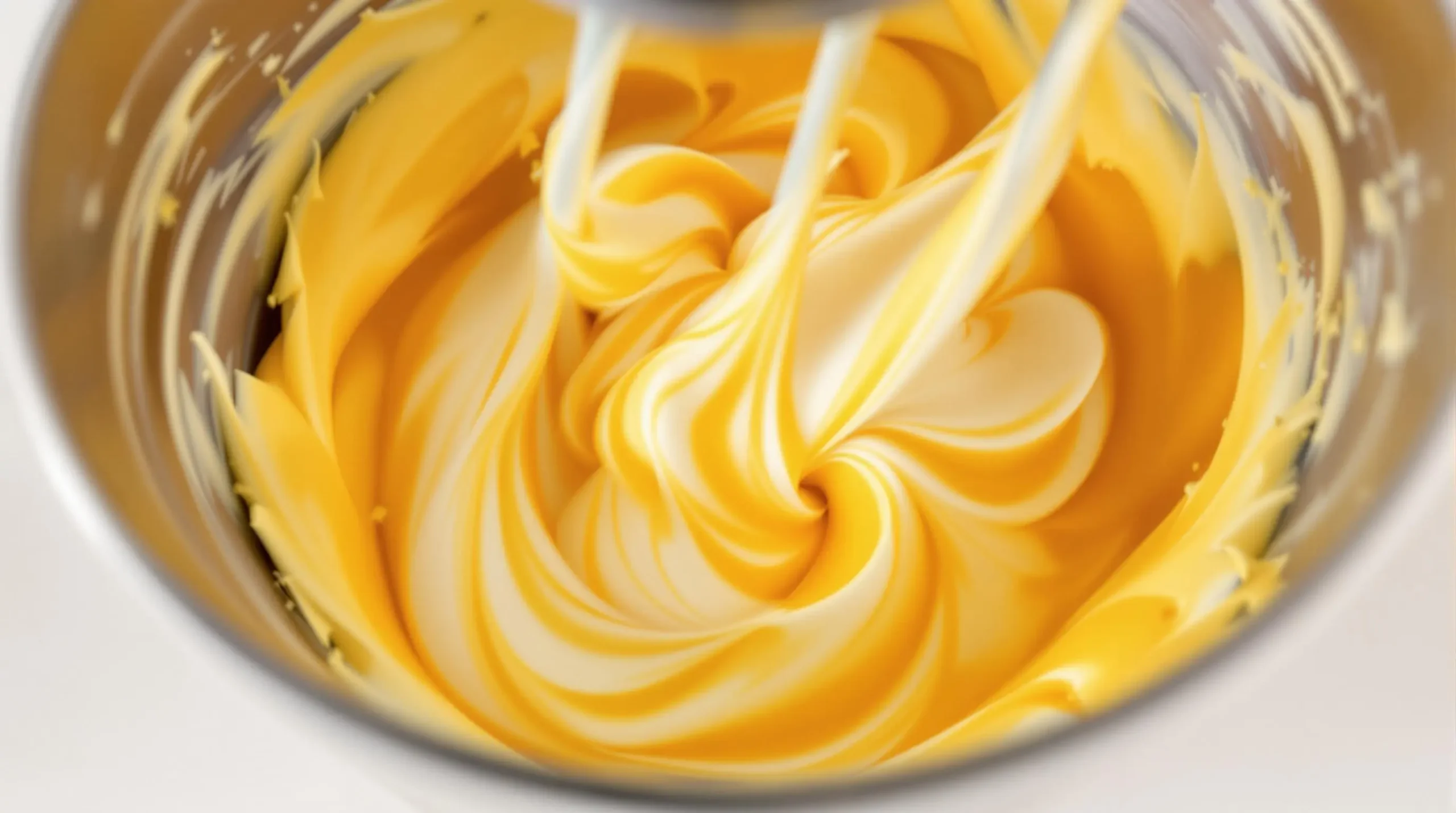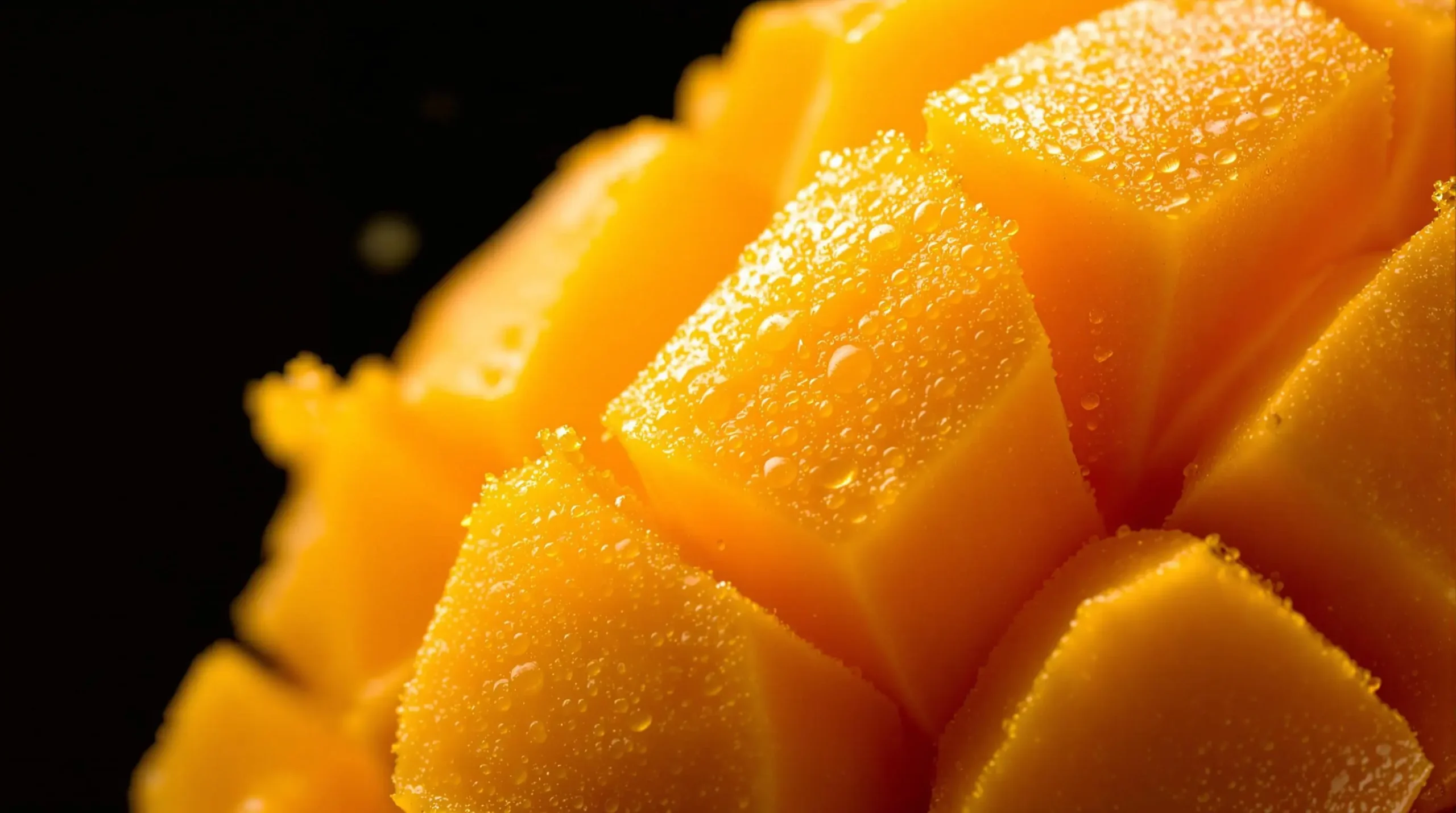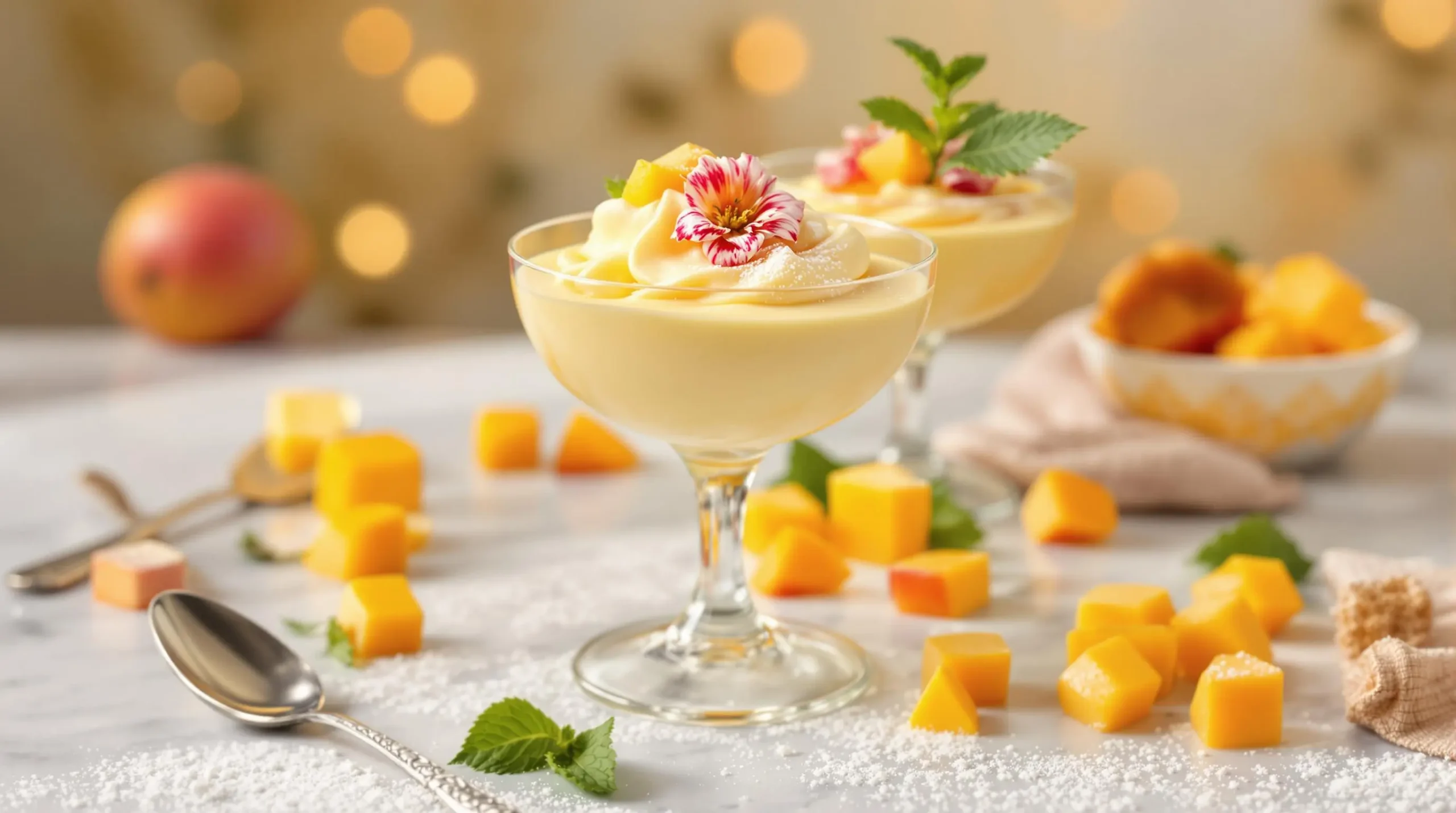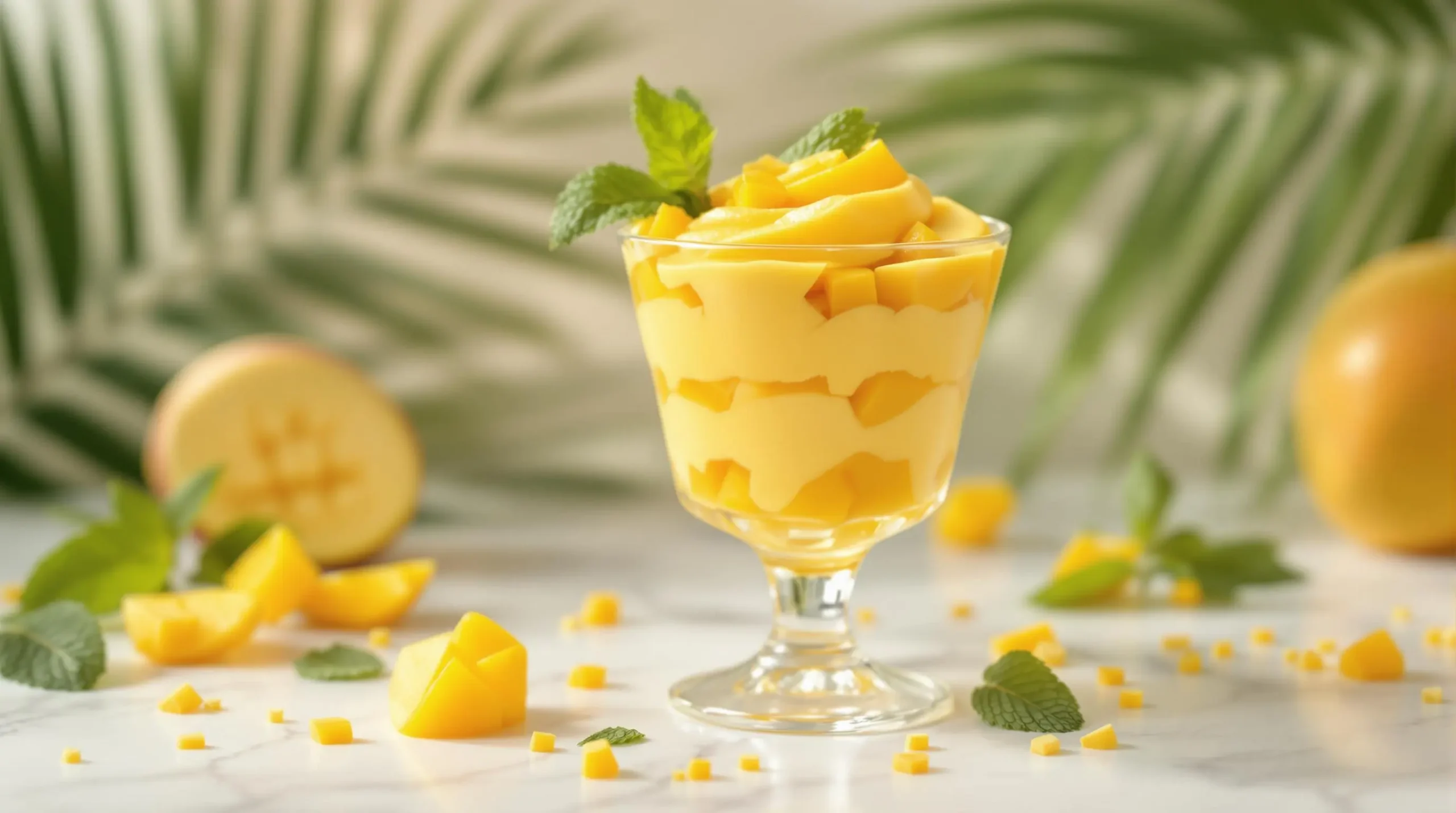Discovering Sweet Tropical Delights
There’s something magical about the way a perfectly ripe mango is used to make some easy mango dessert recipes. Whether it’s the creamy smoothness of a mango mousse or the vibrant layers of a mango trifle, these golden fruits have an incredible ability to elevate ordinary desserts into extraordinary treats.
What makes mangoes a superstar in the dessert world? First and foremost, their natural sweetness means you can often reduce added sugars in your favorite mango varieties. Additionally, these tropical gems pack a powerful nutritional punch, loaded with vitamins A and C, making your mango dessert recipe not just delicious but also somewhat nutritious!
The versatility of mangoes is truly remarkable. From simple no-bake treats to elaborate layered cakes, the possibilities are endless. Learning the proper cutting techniques and storage methods can make a significant difference in your dessert-making journey.
In this guide, you’ll discover how to create show-stopping mango desserts that will impress family and friends. Moreover, you’ll learn essential tips for selecting the perfect mangoes, proper preparation methods, and creative ways to incorporate them into both traditional and modern desserts. Furthermore, we’ll explore how different mango varieties can affect your final creation’s taste and texture.
Ready to embark on your tropical dessert adventure? Let’s dive into the essential techniques that will help you master these delightful treats.
Essential Guide to Mango Selection and Preparation
Choosing the Perfect Mangoes
Creating the perfect mango dessert recipe starts with selecting the right fruit. Among the many mango varieties available, Alphonso and Ataulfo mangoes are particularly excellent choices for desserts due to their creamy texture and intense sweetness. Additionally, Kent and Tommy Atkins varieties work wonderfully in recipes requiring firm flesh.
When choosing mangoes, remember these key indicators of ripeness:
- Gentle give when pressed (not too soft)
- Sweet, fragrant aroma at the stem
- Color changes specific to variety
- No dark spots or blemishes
For optimal results, store unripe mangoes at room temperature. Once ripe, however, transfer them to the refrigerator following these storage guidelines to extend their life by 5-7 days.
Preparing Mangoes for Desserts
Mastering proper cutting techniques is crucial for any mango dessert recipe. The most efficient method is the “hedgehog cut”:
- Score the flesh in a crisscross pattern
- Turn the skin inside out
- Cut cubes away from the skin
For purees, you have several options:
- Blender method: Quick and smooth
- Food processor: Ideal for larger batches
- Manual mashing: Best for chunky textures
While fresh mangoes are ideal, frozen ones can be a fantastic alternative, especially when making smoothies or ice cream. Moreover, they’re pre-cut and often more economical!
Common Mango Dessert Ingredients
Every successful mango dessert recipe requires certain pantry staples. Here’s what you’ll need:
- Dairy basics: Heavy cream, milk, butter
- Sweeteners: Granulated sugar, honey, condensed milk
- Binding agents: Gelatin, cornstarch, agar-agar
- Flavor enhancers: Vanilla extract, lime juice, cardamom

Furthermore, keep these substitution options handy:
- Coconut cream for heavy cream (vegan option)
- Maple syrup or agave for honey
- Chia seeds for gelatin (vegetarian option)
When measuring mangoes, remember these guidelines:
- 1 medium mango = about 1 cup chopped
- 2 cups chopped = 1 cup pureed
- 3 medium mangoes = 1 pound
Learning these fundamentals will significantly improve your dessert-making success. Additionally, understanding the relationship between ingredients helps you adapt recipes confidently. Most importantly, don’t be afraid to experiment with different combinations while maintaining proper proportions.
Remember, the key to outstanding mango desserts lies in starting with quality ingredients and proper preparation techniques. Subsequently, you’ll find that even complex recipes become manageable when you’ve mastered these basics.
Classic Mango Dessert Recipes That Never Fail
Creating the perfect mango dessert recipe doesn’t have to be complicated. In fact, some of the most beloved mango treats are surprisingly simple to make. Let’s explore three timeless classics that showcase the natural beauty of mango varieties in different ways.
No-Bake Mango Mousse
This light and airy mango dessert recipe is perfect for warm summer days. Furthermore, it requires minimal effort while delivering maximum flavor!
Essential ingredients:
- 2 ripe mangoes, pureed
- 1 cup heavy whipping cream
- 3 tablespoons powdered sugar
- 1 envelope unflavored gelatin
- ¼ cup cold water
Follow these simple steps:
- Bloom gelatin in cold water
- Heat briefly until dissolved
- Fold into mango puree
- Whip cream with sugar
- Combine gently with mango mixture
For the perfect texture, remember these tips:
- Use room temperature mango puree
- Don’t overwhip the cream
- Fold ingredients gently to maintain airiness
- Chill for at least 4 hours
Mango Float/Royale
This beloved Filipino dessert transforms simple ingredients into layers of pure joy. Additionally, it’s a fantastic make-ahead option following these storage guidelines.
Key components:
- Graham crackers
- Whipped cream
- Ripe mango slices
- Condensed milk
Layering technique:
- Line container with graham crackers
- Spread whipped cream mixture
- Arrange mango slices
- Repeat layers
- Freeze for 4-6 hours
Asian-Style Mango Pudding
This silky smooth dessert perfectly balances fresh mango flavor with creamy richness. Moreover, proper cutting techniques are crucial for the garnish.
Essential elements:
- Fresh mango puree
- Gelatin sheets
- Evaporated milk
- Sugar to taste
- Coconut milk (optional)
Tips for perfect results:
- Use premium mangoes for best flavor
- Strain puree for silky texture
- Don’t overheat gelatin mixture
- Cool gradually for smooth setting
Serving suggestions:
- Top with fresh mango cubes
- Add condensed milk drizzle
- Garnish with mint leaves
- Serve with evaporated milk
Each of these classic recipes offers a unique way to enjoy mangoes. While the mousse celebrates their creamy texture, the float highlights their natural sweetness, and the pudding showcases their intense flavor. Most importantly, these desserts prove that simple techniques can yield impressive results.
Remember to choose perfectly ripe mangoes for optimal flavor. Subsequently, follow the preparation steps carefully, and don’t rush the setting or freezing times. Finally, feel free to adjust sweetness levels according to your mangoes’ natural sugar content.
Tips for Perfect Mango Desserts
Creating a flawless mango dessert recipe requires attention to detail and understanding common challenges. Moreover, knowing how to store and present your creations can elevate them from good to extraordinary. Let’s explore essential tips that will help you master these tropical treats.
Common Troubleshooting
Every mango dessert recipe can present unique challenges. However, most issues have simple solutions:
Texture Problems:
- Runny mousse: Usually caused by overripe mangoes; drain excess liquid before use
- Grainy pudding: Strain puree thoroughly and heat gradually
- Dense texture: Avoid overmixing when folding ingredients
Additionally, consider these solutions for other common issues:
- Prevent browning by adding citrus juice
- Fix overly sweet desserts with a pinch of salt
- Combat setting problems by following proper storage guidelines
Storage and Make-Ahead Tips
Proper storage is crucial for maintaining the quality of your mango varieties desserts:
Refrigeration Guidelines:
- Mousse: Up to 3 days covered
- Pudding: 4-5 days in airtight containers
- Fresh garnishes: Prepare just before serving
Freezing Instructions:
- Wrap tightly to prevent freezer burn
- Label with date and contents
- Thaw gradually in refrigerator
- Use within 2-3 months

Presentation Ideas
The visual appeal of your mango dessert recipe is just as important as taste. Furthermore, proper cutting techniques ensure beautiful garnishes.
Garnishing Suggestions:
- Fresh mango fans or roses
- Mint or edible flowers
- Toasted coconut flakes
- Candied lime zest
Plating Techniques:
- Use warm plates for cold desserts
- Create height with layering
- Add texture contrasts
- Consider color combinations
Serving Recommendations:
- Temperature matters: serve mousse well-chilled
- Portion sizes: 4-6 ounces is ideal
- Accompaniments: coconut cream, fresh berries
- Timing: remove from refrigerator 5-10 minutes before serving
Most importantly, remember that presentation should enhance, not overshadow, the natural beauty of mangoes. Additionally, consider your audience when choosing plating styles – elegant for formal occasions, playful for casual gatherings.
Finally, successful mango desserts often come down to timing and temperature control. Subsequently, planning ahead and understanding proper storage techniques will ensure your creations look and taste their best. While perfect presentation takes practice, these guidelines will help you create Instagram-worthy desserts that taste as good as they look.
Remember to keep your garnishes simple yet effective, and always ensure they complement rather than compete with the main dessert. Moreover, practice these techniques regularly to develop your own signature style in presenting tropical desserts.
Frequently Asked Questions About Mango Desserts
After exploring various mango dessert recipes, here are answers to the most common questions that home bakers ask about creating these tropical treats.
Can I use frozen mangoes for these desserts?
Yes, frozen mangoes work well in most mango dessert recipe variations! While fresh mangoes are ideal for garnishing and raw applications, frozen ones are perfect for purees, smoothies, and baked goods. Moreover, they’re often more consistent in sweetness and pre-cut for convenience. Simply thaw them completely and drain excess liquid before use.
How do I prevent my mango desserts from becoming too runny?
The key to preventing runny desserts lies in proper moisture control. First, drain excess liquid from pureed mangoes. Additionally, ensure gelatin is properly bloomed and measured accurately. For no-bake desserts, thoroughly chill ingredients before combining them. Furthermore, when using frozen mangoes, drain them completely after thawing.
What’s the best way to achieve the right sweetness level?
Start with ripe mangoes, as they provide natural sweetness. Furthermore, always taste your mangoes before adding sugar, as sweetness varies between varieties. Add sweeteners gradually, tasting as you go. Most importantly, remember that chilling desserts can dull sweetness, so make mixtures slightly sweeter than desired.
How long can these desserts be stored?
- Refrigerated items (mousse, pudding): 3-4 days
- Frozen desserts (mango float): Up to 2 weeks
- Baked goods with mango: 2-3 days
- Fresh mango garnishes: Best used immediately
Can I make these desserts ahead of time?
Most mango desserts can be prepared in advance. In fact, some recipes like mango float actually improve with overnight chilling. However, add fresh garnishes just before serving. Additionally, ensure proper storage temperatures and container sealing to maintain quality.
What should I do if my mangoes aren’t ripe enough?
- Place them in a paper bag with a banana
- Store at room temperature
- Check daily for ripeness
- Once ripe, refrigerate to slow the process
Remember, successful mango desserts depend largely on the quality and ripeness of your fruit. Subsequently, taking time to select and properly prepare your mangoes will significantly impact your final results.
Bringing Mango Magic to Your Kitchen: Final Tips and Takeaways
As we wrap up our comprehensive guide to creating the perfect mango dessert recipe, let’s highlight the key elements that will ensure your success in crafting these tropical delights. Furthermore, understanding these fundamentals will give you the confidence to experiment with your own creative variations.
First and foremost, remember that quality ingredients matter immensely. Selecting the right mango varieties for your specific mango dessert recipe can make the difference between a good dessert and an exceptional one. Additionally, proper ripeness and storage following these storage guidelines ensure optimal flavor and texture in your creations.
Master these essential techniques for consistent success:
- Perfect your cutting techniques for professional-looking results
- Balance sweetness by tasting as you go
- Control moisture content for ideal texture
- Practice proper temperature management
Most importantly, don’t be afraid to experiment! While classic recipes provide a solid foundation, your unique twist might create something extraordinary. Moreover, remember that even experienced bakers sometimes face challenges – each attempt is a learning opportunity.
Ready to start your mango dessert journey? Here’s your action plan:
- Stock your pantry with essential ingredients
- Practice basic preparation techniques
- Start with simpler recipes
- Gradually tackle more complex creations
- Document your successes and learnings
Remember, the joy of creating mango desserts lies not just in the final result, but in the creative process itself. Whether you’re making a simple mango mousse or an elaborate trifle, each dessert is an opportunity to bring tropical happiness to your table. Finally, share your creations with loved ones – after all, desserts taste better when shared!

Now, armed with knowledge and inspiration, it’s time to head to your kitchen and start creating your own mango masterpieces. Happy baking!

